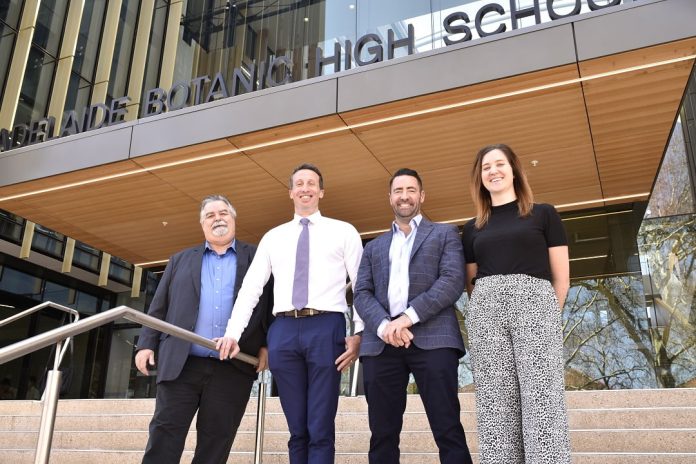Access Datacom, with support from Gallagher, has integrated an access control, intrusion detection and automation solution for the new Adelaide Botanic High School. Incorporating Salto wireless and Bosch video surveillance, the 205-door Gallagher system is built around a virtual environment that may become a standard for South Australian schools in the future.
SECURING schools is challenging. They combine complex facilities, with significant staff and student populations and operational contradictions demanding sites be accessible yet secure. At Adelaide Botanic High School, these challenges are exaggerated by the fact the site is located within public space, making defence in depth impossible. The answer was lengthy planning and a willingness to stretch existing technologies to their limits. The result is a cleverly integrated solution unlike anything we’ve seen before.
Adelaide Botanic High School is a rebuild and expansion of the old Reid Building, formerly part of the University of South Australia, purchased to provide a second city high school. The completed site comprises the 6 levels of the former Reid Building, 7 levels of the new building with these 2 towers connected by a 6-level atrium. High rise schools are unusual and during the planning stages it was decided that Adelaide Botanic High should be unlike any other school in South Australia, with a strong focus on contemporary, interdisciplinary learning and teaching.
The school’s limited footprint means the grounds barely extend past the buildings, so managing and securing the site meant bringing layers of defence inside the structure. It’s here that the brilliance of the school’s security and automation concept really starts to shine through because to make an open school closed, designers need to empower staff and students to manage operational elements of the security system in real time.
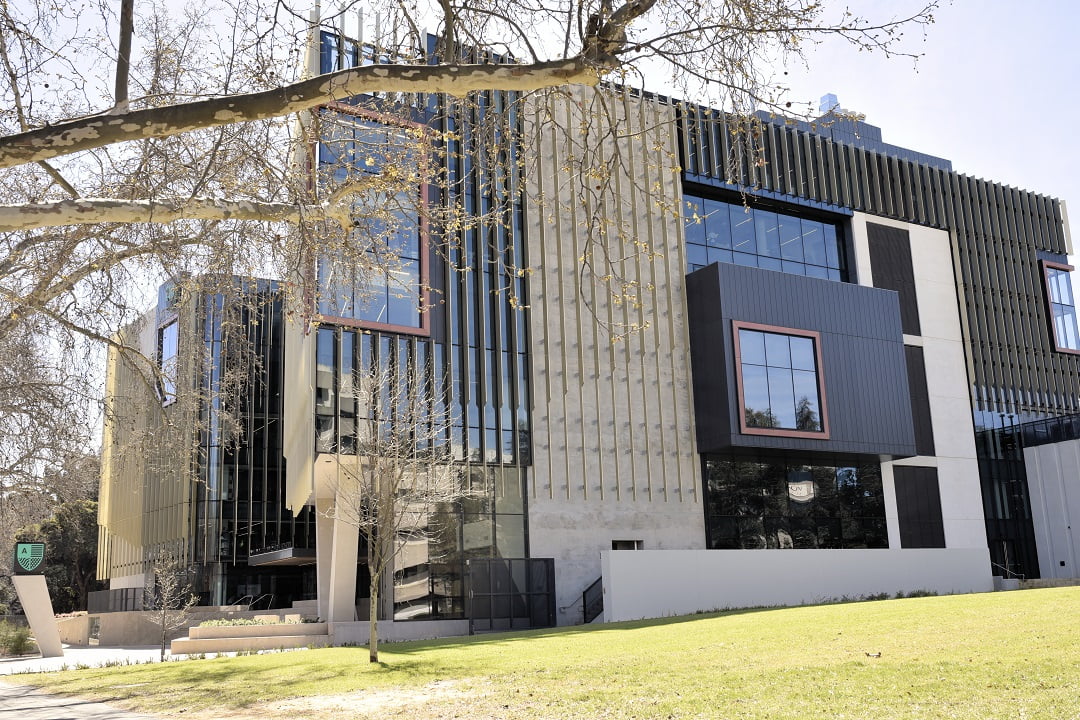
You approach Adelaide Botanic High through open space – I’ve arrived with Gallagher’s Karl Harris and Samantha Gibbons and we cross the park from the zoo and walk up Frome Street. The school building emerges out of green space, the design elements of glass and fluted sunshades contrive to lighten what might have been a heavy structure. Climbing the stairs into the foyer, the atrium draws your eyes upwards into open space illuminated from all directions by natural light and reflections from timber.
According to Gallagher’s Karl Harris, Adelaide Botanic High School is a unique facility.
“Part of the vision for Adelaide Botanic High School is to prepare secondary school students for university and other vocational pathways – it’s very open, very similar to a tertiary campus,” he explains. “There are about 350 students currently and this will scale up to 1200 in 2022 through a staged process over a number of years.
“We’ve been involved with the Department for Education from the beginning in the design, the planning, what the look and feel of the system would be, planning the safe zones and how they could lock down – getting all this right was a process that required teamwork with George Dunleavy, strategic manager – security and emergency management and agency security advisor for the Department for Education heavily involved.
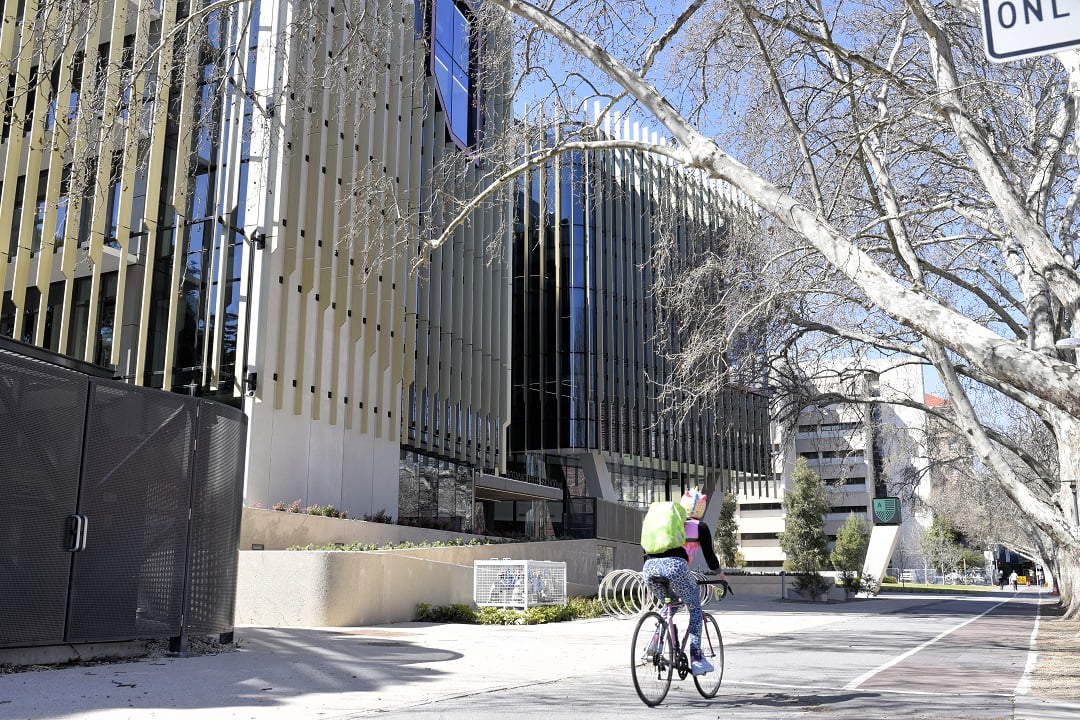
“George looked very carefully at what was available on the market so as to provide safe spaces, to deliver notifications to students on site, possibly even notify parents with automated or customised messages,” Harris says. “Access Datacom was selected as the integrator and they were also involved from the planning stages.”
Harris says the importance of the level of control stems from the fact the school is located right on the parklands and has no closed boundary.
“The Department for Education was very concerned about people being able to walk in – the potential for active incident issues can be high with fluid boundaries so plenty of thought needed to go into designing the facility and its security solution to facilitate staged lockdowns,” he explains.
“To achieve this, they wanted an integrated system that could do a combination of wired and wireless doors (Salto) for internal doors. Operationally, they wanted to be able to lock down areas of the school in real time by swiping a reader or using a mobile app to create a safe zone in real time.”
Operational Considerations
Building a new school has a timeline – in this case, the planning stretched back to 2015 and ramped up after the purchase of the Reid Building. A unique facility imposes conceptual demands on the planners, and these are made more intense when the site is greenfield.
“The challenge for us security-wise was how to create a security solution for a new type of school that doesn’t yet have a principal, or a student cohort,” Dunleavy explains. “You are working on how you think the school is going to operate. We decided what we thought the school should look like in terms of the operation – we assumed certain doors would be open all the time and worked towards making the school secure while allowing free movement. A positive was that we designed the school to operational requirements – this was ultimately shown to be the right approach. The school can be open, it can be locked down in zones, or it can be completely secured.”

According to Dunleavy, the security system at Adelaide Botanic High School evolved from the ground up.
“We asked ourselves: How will students use this door? How will staff use this door? We then designed each access point around that expected functionality,” Dunleavy says. “The planning process took about 18 months – the overall plan of the site, the door schedules, dividing the school into physical safe zones, working out what door hardware was required for each access point and how we would achieve that – all this was time consuming.
“We said from the start we wanted this to be a Gallagher site with the capacity to integrate to wireless locksets. Given we did not know how the school would be used, including wireless locksets into the overall solution allowed us the flexibility to replace standard door hardware during an evolving process. Salto has been the department’s preferred wireless access control solution for a number of years and the fact that Salto integrates into the Gallagher access control solution was vital for us.”
The site presented its own constraints and pressures throughout the planning stages.
“In terms of the original design concept, the open atrium was always going to be a security problem for us,” Dunleavy says. “Then there’s the school’s proximity to parklands and the fact it’s not immediately identifiable as a school from all sides if you’re not familiar with it. Tourists approaching from the zoo or Botanic Gardens might think it’s a gallery or a museum. There’s also an area that looks like a café. Most things in schools are designed to be open with security around the perimeter, but we could not do that here without a perimeter and all these contradictions required a system that could be managed in real time.”
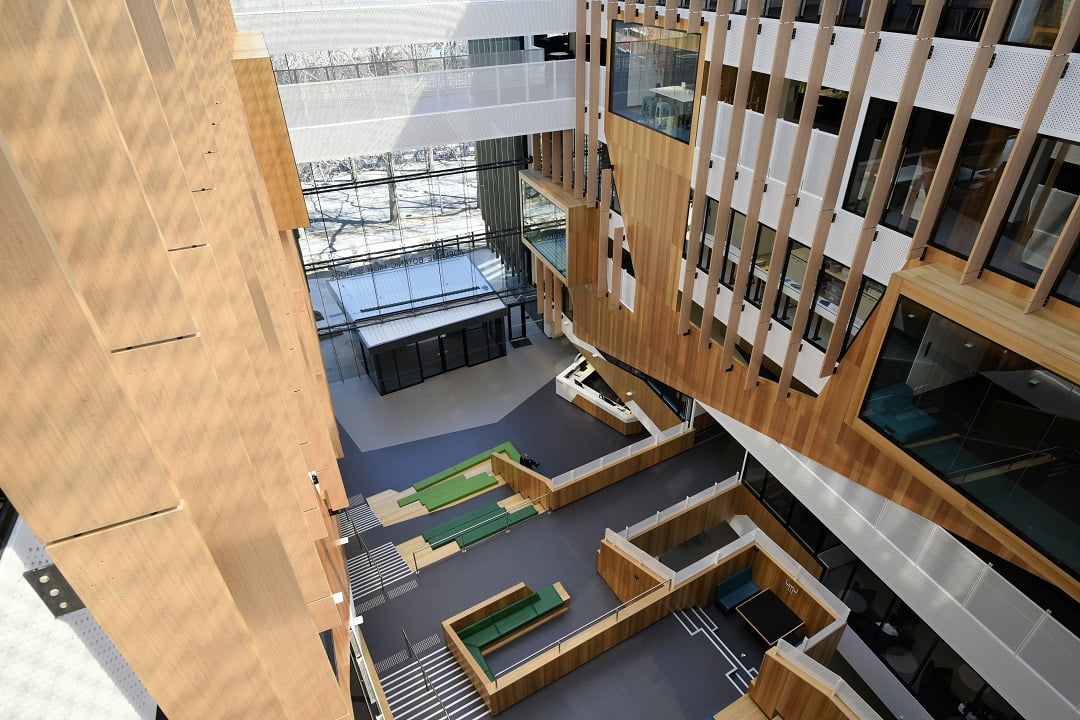
According to Dunleavy, once a principal and leadership team were appointed, the faculty inevitably started to design operational elements of the school around how they wanted things to work – this included placing a permanent receptionist on the ground floor. These sorts of changes to operational practice meant the school began to evolve away from the original plan for the functional security design.
“Typically, the operational requirements of a school govern the security system, but every school is different,” he explains. “For instance, we only have Years 8 and 9 on the campus – we need to allow those students access to everywhere they need to be but nowhere else. There are large areas of the school that are not being used and these areas are all currently locked down. Then there are areas like the science labs and the library where students need to be escorted – that operational side will naturally evolve as student and staff numbers expand.”
Dunleavy acknowledges the team was lucky when it came to the confluence of operational requirements and developments in technology.
“We have been fortunate with the way the integration between Salto and Gallagher has evolved since the day we decided we would use them together on this site,” he explains. “We actually decided to commit to Salto’s Gateway 3 hardware before its integration with Gallagher was complete – this decision revolved around the architects and the builders needing to know what we planned to install well in advance and we wanted the most aesthetic door hardware available so we had to take a bit of a gamble. But everything has come together well.”
The Gallagher Solution
At the heart of the Adelaide Botanic High School integration is Gallagher Command Centre, which allows management, reporting and event notifications at workstations or via the Gallagher mobile app. Command Centre is a highly polished and powerful solution that handles events, alarms, cardholders, resources and more. There’s detailed alarm reporting with filters, as well as situational awareness reporting on evacuations and contextual reporting.
Given the nature of the school, notifications are an important feature of the system and cover alarms and events, card expiries, broadcast notifications and automatically configured cardholder location lists. Notifications can be sent via email, SMS or through mobile notifications, and the system allows lockdown of areas in the event of threats or emergencies – these are key features of this application.
The structure of access privileges can be complex with Command Centre. While there’s less in the way of required competencies in a high school application, these inherent capabilities give the system plenty of potential to support staff certifications where applicable. Importantly, all changes to cardholder details and access privileges propagate to field controllers automatically.
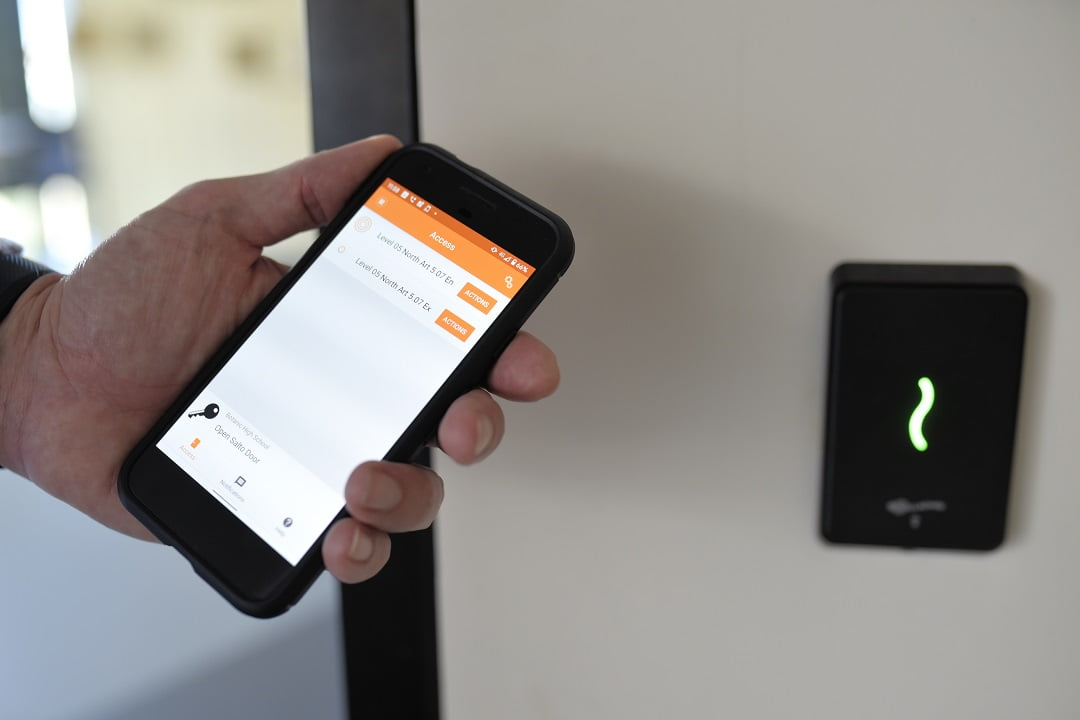
For staff, Gallagher’s Bluetooth app is their interface with the system, and it has plenty of power, including the ability to manage alarms, undertake overrides, remotely monitor system-wide access points and alarm zones. Then there’s the all-important triggering of pre-configured macros to undertake zone or area lockdowns. The app also allows a mobile device to be configured as a fully functioning mobile access reader.
Cleverly, and thanks to the recent upgrade to Gallagher 8.10, Mobile Connect can be used by staff to gain access to Gallagher doors and Salto doors. Mobile Connect is a secure universal log-in solution that works by matching users to their mobile phone, allows them to log-in to websites and applications quickly without the need to remember passwords and usernames. It’s safe, secure and no personal information is shared without permission.
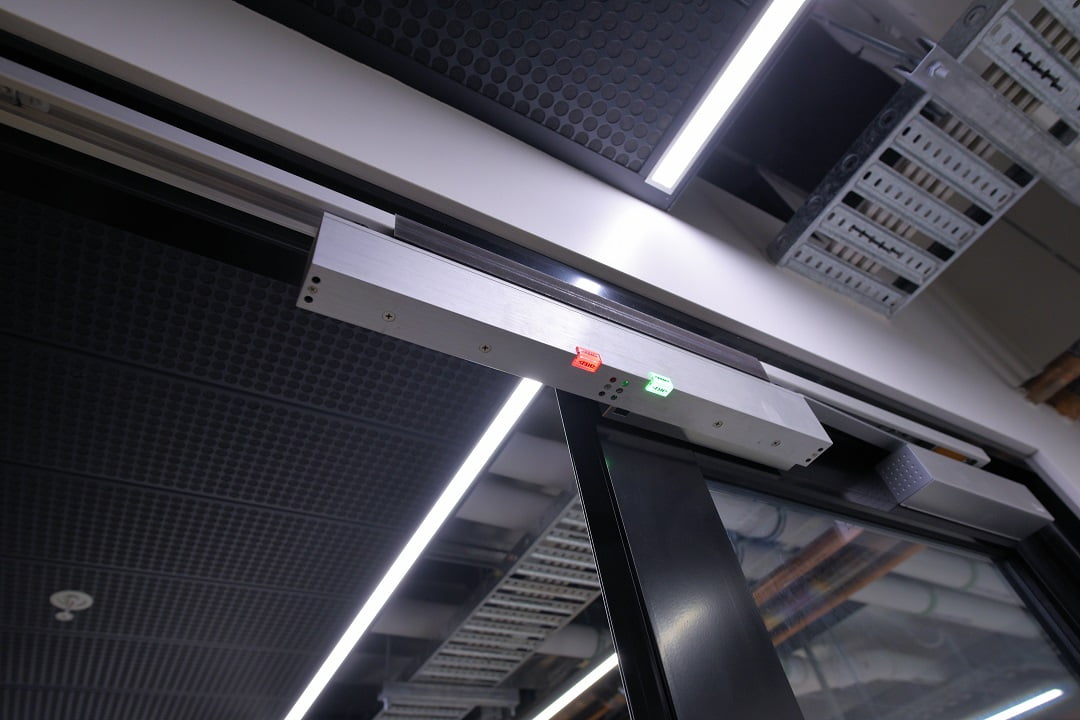
Command Centre can also manage visitor access, including undertaking pre-registration and visitor management. Visitor management is important in a school environment, where admin staff, support teachers and maintenance contractors need to be empowered to carry out their tasks while appropriate security levels and granular audit trails are maintained. With contractors who might need access to locations deep in the facility, this is more complex than you’d think.
Another defining feature of the Gallagher system here is support for DESFire EV2 credentials, which are in use by all staff and will be phased in to replace the current DESFire EV1 student ID cards as the school’s card supplier ramps up its manufacturing capabilities. Importantly, Adelaide Botanic High School developed its own card template and during the planning process this template was applied to the high security DESFire credentials and integrated with the Adelaide Metro pass, which allows travel on trains and buses. Pretty neat.
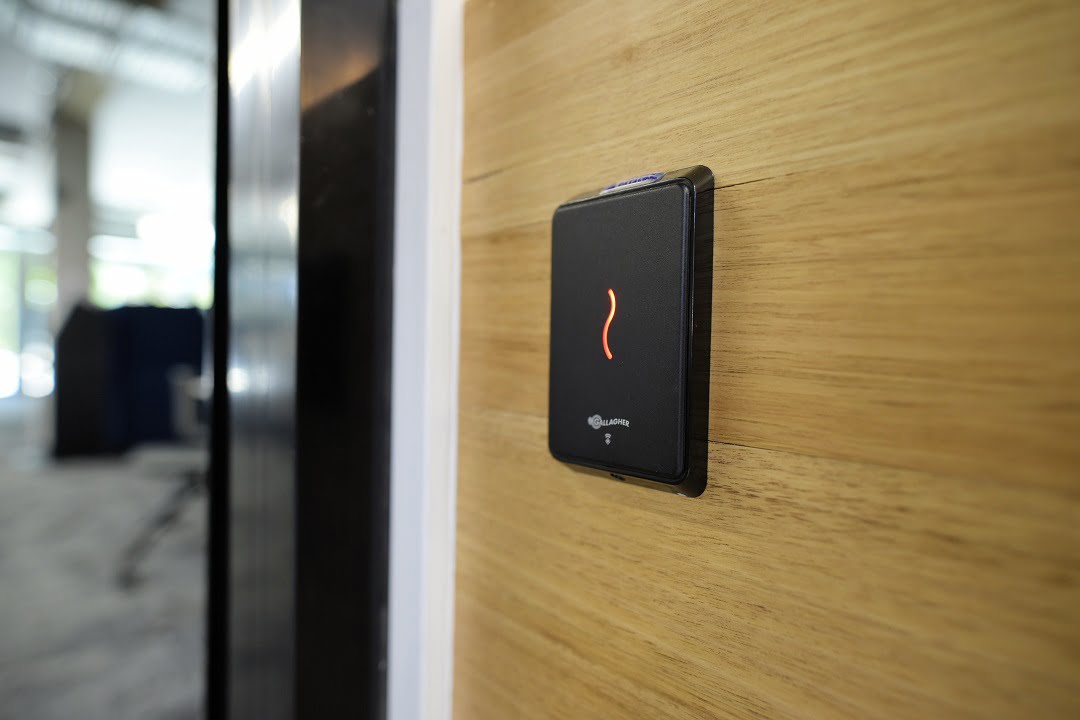
Gallagher was involved along the way during the integration, assisting wherever required. There’s no doubt Gallagher’s development of the last couple of years created an almost perfect synergy with the operational demands of the school. It seems tailor-made for the job. According to Harris, this comes down to the fact Gallagher has supported schools and universities for decades.
“Importantly for the school, the Gallagher system can do escalated lockdowns as well as managing notifications via an app, so the principal can lock the school down or just lock down parts of it and teachers can also lock down the areas they are in,” Harris explains. “These are functionalities the system already has.
“The latest version of Gallagher also allows the use of the Gallagher Bluetooth app to open Salto doors – we’ve found teachers are very comfortable using their own smart devices to manage the access control and security system.”
“As well as trialling the app, teachers may also use NFC for authentication – these additional functionalities are part of a service level agreement and Gallagher continues to deliver new functionality as required,” Harris explains.
“Adelaide Botanic High School has also done unique things with students using DESFire credentials. The high security cards resist card cloning and copying and to make the cards more useful for the students they have integrated the Metro bus pass into their access credentials.
“And the system also does cool things with visitor management. As well as managing contractors coming to the site via a kiosk, we are doing some work around integrating a clearance database of those staff certified to work with students, which is something that could be integrated to all schools in the future.”
Walking The Site
We start our tour of the site in the basement bike storage area. Like the rest of Adelaide Botanic High School – including the staff bathrooms – this area is access controlled. After looking around, we head upstairs to the ground floor. As we go along, Dunleavy points out challenging areas and as often as not these hinged on uncertainties about the way parts of the site would be used before it was occupied.
“We wanted to try and keep the safe zones on the Gallagher system and the general access areas on the Salto system and this was one of the most difficult challenges for us during planning and implementation,” he explains. “For instance, we didn’t know what this space was going to be used for (the breakout and teaching space outside the library).
“We knew it was a teaching space but that was all we knew. At the same time, we could see it was a teaching space that was so accessible you could walk into it off the street if the reception team was not in a position to challenge you. Doors might be chocked open during the school day and older students are operating under broad supervision so there’s not going to be a teacher up the front of a classroom and rows of desks like you might have found 10 years ago.”
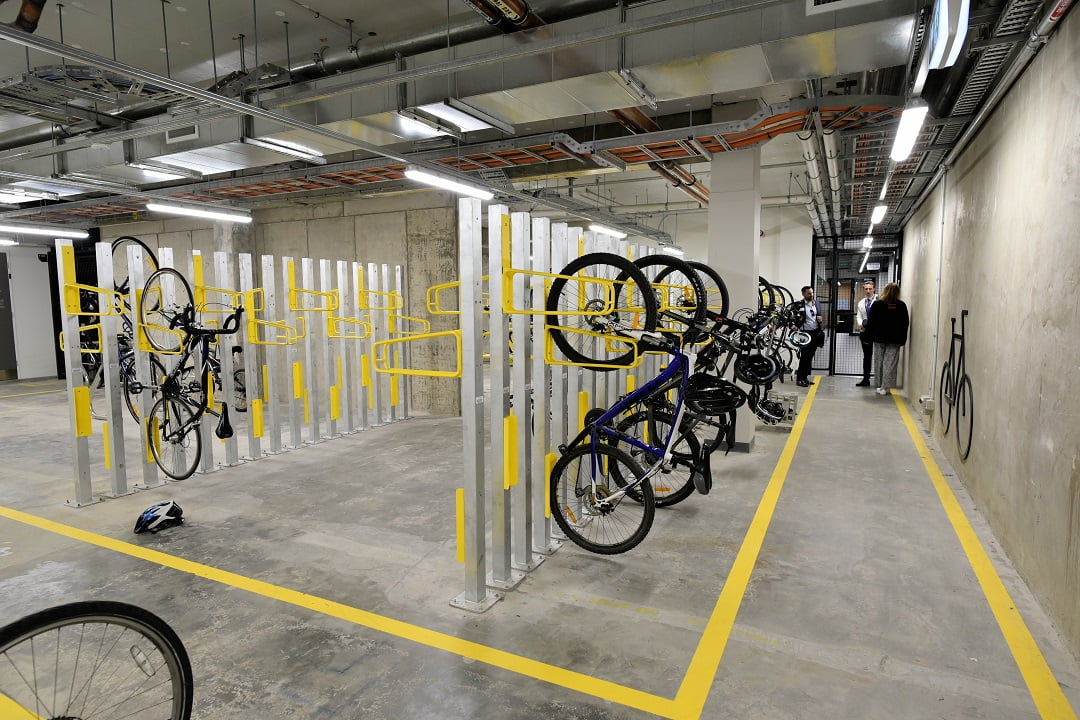
“The way we managed this was that instead of staff being the only ones able to lock this area down, there’s a privacy setting – an electronic snib – that allows students to lock the classroom if they are the closest person when an incident occurs, without the need for teachers or other staff to run to every door or activate an emergency process,” Dunleavy explains.
“While students are empowered to look after their own safety, staff can override that electronic snib via their own devices or credentials to deal with accidental lock-ins, with snib events able to be sent to staff as notifications so that they are aware the door has been locked and can respond accordingly.
“We also needed to manage hiring out the gym – in this case, people need access to the gym and nowhere else, so we needed to block off adjacent zones, as well as providing toilet facilities nearby. And something else we needed to manage was door setup of fire doors which would be controlled by the fire system but are part of the lock-down zones. To create and manage lockdown zones, we needed fire doors to be part of the security system. This meant there needed to be additional integration. Further, these doors close and lock at a set time of day and we could not manage that from the fire system – they are all controlled by timer from the access control system.”
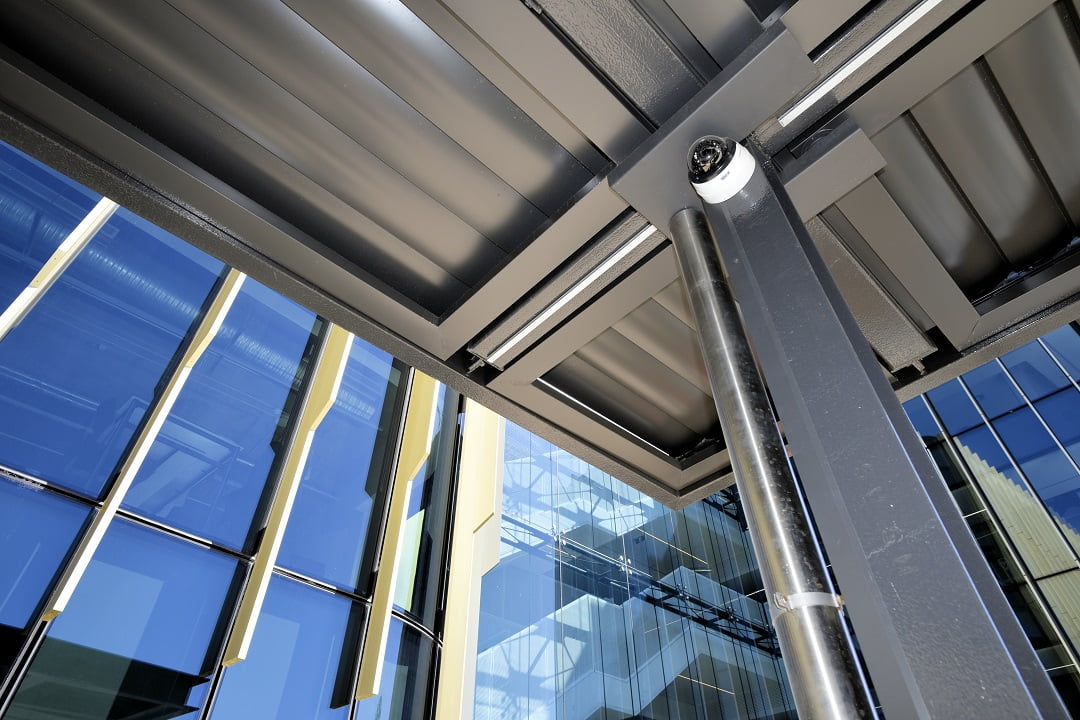
We walk outside on a park-facing terrace and it’s out here you get the first sense of the school’s tiny footprint. There are some students out here having a break but aside from an integrated and partially covered breakout area with tables and benches, there’s nowhere else to be but the park. And that’s the issue the security team and system designers wrestled with – building a secure site when you have no room for forward defence.
“The footprint of the building you can see is our area – everything beyond our facility is outside our control – that includes things like security patrols around the perimeter, which are outside the school grounds – and being parkland, that footpath right there is a public thoroughfare,” says Dunleavy.
“The way the system is designed, if a person comes onto the school property who should not be there, then students can be moved into secure areas through gates like that one – he points – and the area or the entire site can be locked down while a staff or police response is actioned.”
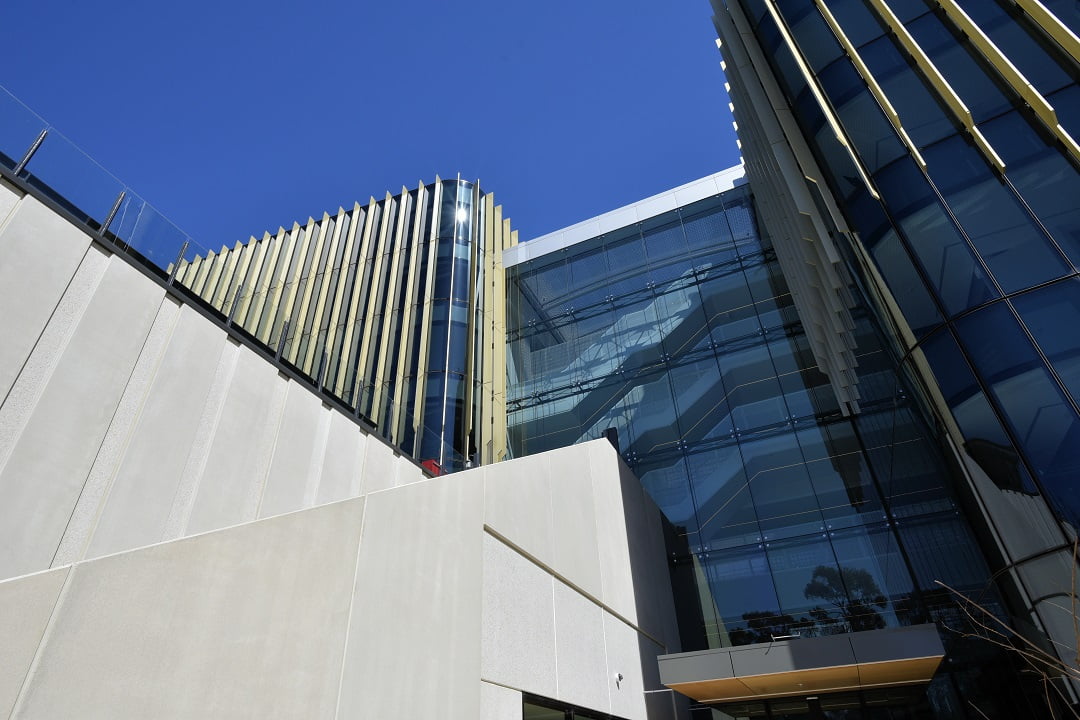
Every application expresses tension between different operational demands and Adelaide Botanic High School is no different.
“From the point of view of security management there’s always a conflict between architecture and security management,” says Dunleavy. “When we did the final walk around of the building, we thought some areas were too accessible. But we designed the system to cover these areas and we are happy with the balance. For instance, we needed to be able to open these bi-fold doors leading to the library, but we needed to be able to secure them and monitor their state as well because they are our perimeter.
“The original plan for the school was for it be keyless – that’s what we wanted. And we also needed contractors to be able to access crucial areas in a way that was managed. This system allows system managers and the school to know who is on site and who is not on site, with the potential for controlling the level of contractor access that was vital to us.”
Something I point out as we move around are the Bosch cameras, which are installed inside and outside the facility. According to Dunleavy, there’s no integration of the CCTV solution and the access control system – instead, a separate BMS is managing video surveillance. CCTV at Adelaide Botanic High is about evidence-based investigation, not live monitoring. The primary focus of CCTV here is that all important and very thin perimeter and its access points.
“What we tried to do was provide as much CCTV coverage as possible with the minimum number of cameras,” Dunleavy explains. “There are dome cameras outside and inside we used hemispheric cameras so that in an investigation we know someone has passed through an area or an access point – we don’t want staff or students to feel they are being watched. It’s about finding a balance.”
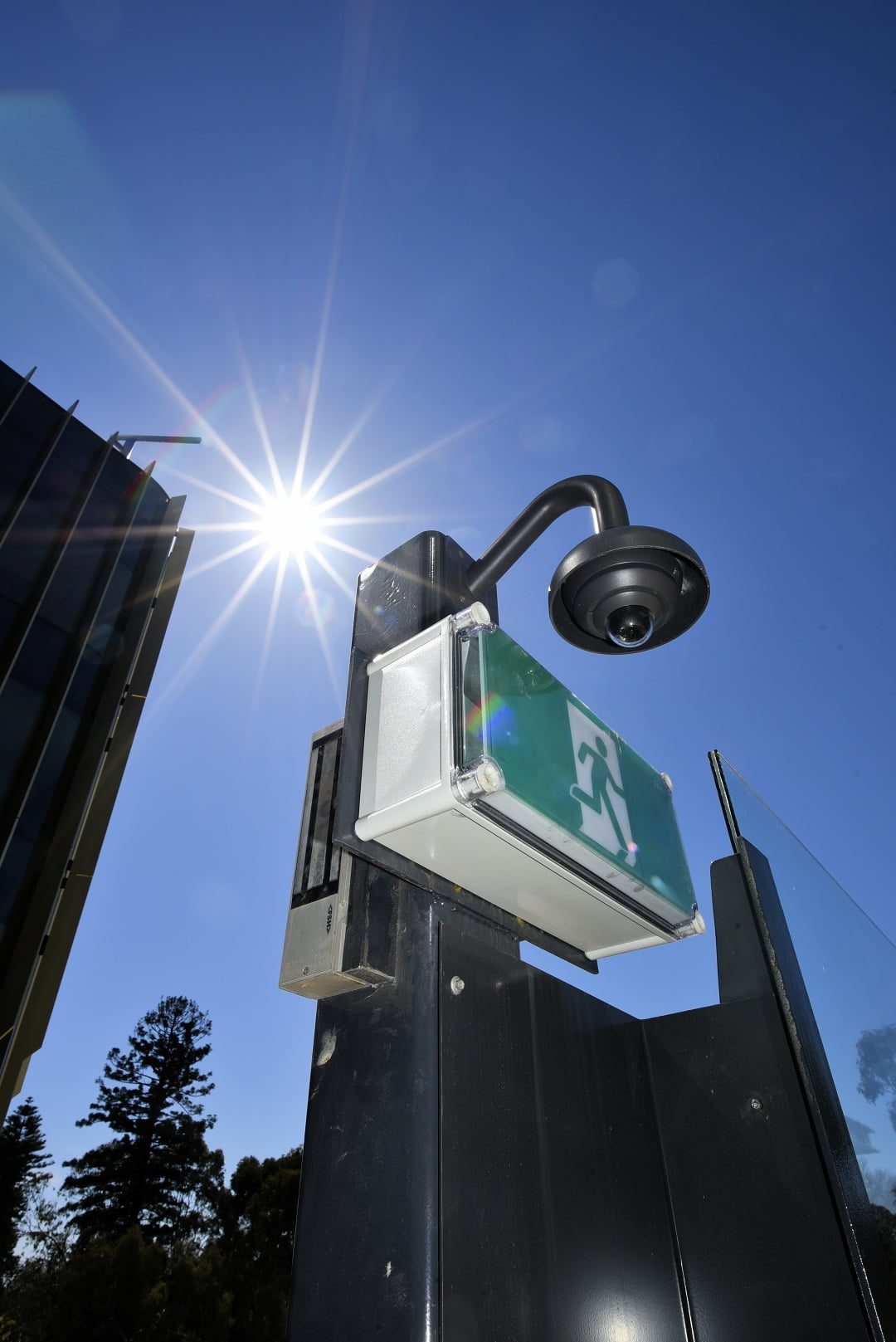
Something CCTV and video analytics do offer are excellent virtual perimeters and importantly, analytics is integrated into Bosch cameras and could be used to notify events like line crossing. Video analytics could also allow intrusion and object detection after hours. Then there’s the benefit of video verification of alarm events.
“The next steps we plan involve working out how to use the existing cameras to work out when there’s a problem in certain areas and to integrate these events through to the Gallagher system allowing notification and response,” Dunleavy says.
Next, we go up in the lift to the staff admin area and on the way, we pass the reception area that was included in the original design before the site was occupied and reception moved to the ground floor. Once again, George points out the obvious challenge – visitors exit the lift into what should be a sterile zone.
“You can see the first thing a visitor encounters as they get out of the lift and approaches this reception area is classrooms and our design protected these using a changing state model. If they are normally open, or normally locked then teachers can arm the area with a swipe of their access card, and this also sends a notification to appropriate staff so they can check what is going on. This design avoided use of duress or pendant alarms, while giving proactive functionality.”
Installation and Challenges
Along with all the usual challenges of working around construction and sharing space with other trades, Access Datacom and Gallagher needed to fit in with the 12-month timeline of the entire build. Given everything that needed to be done, this imposed stresses on all contractors. Adding to the complexity was the fact that while the team started out working towards a planned design, the goalposts began shifting once staff and students moved into the school.
According to Rick Pfitzner, managing director of integrator Access Datacom, a team of 8 technicians worked around the site at busy times but for the most part a team of 4 handled the access control, intrusion detection, video surveillance and visitor management installations. Adding to the burden for Access Datacom was the fact the team does all its own work.
“When it comes to challenges this integration went according to plan but that came back to the fact we sat down with George right at the start and talked about what was required,” Pfitzner explains. “There were some enlightening design meetings at which we asked a lot of questions but we’re happy with the solution and so is the client.”
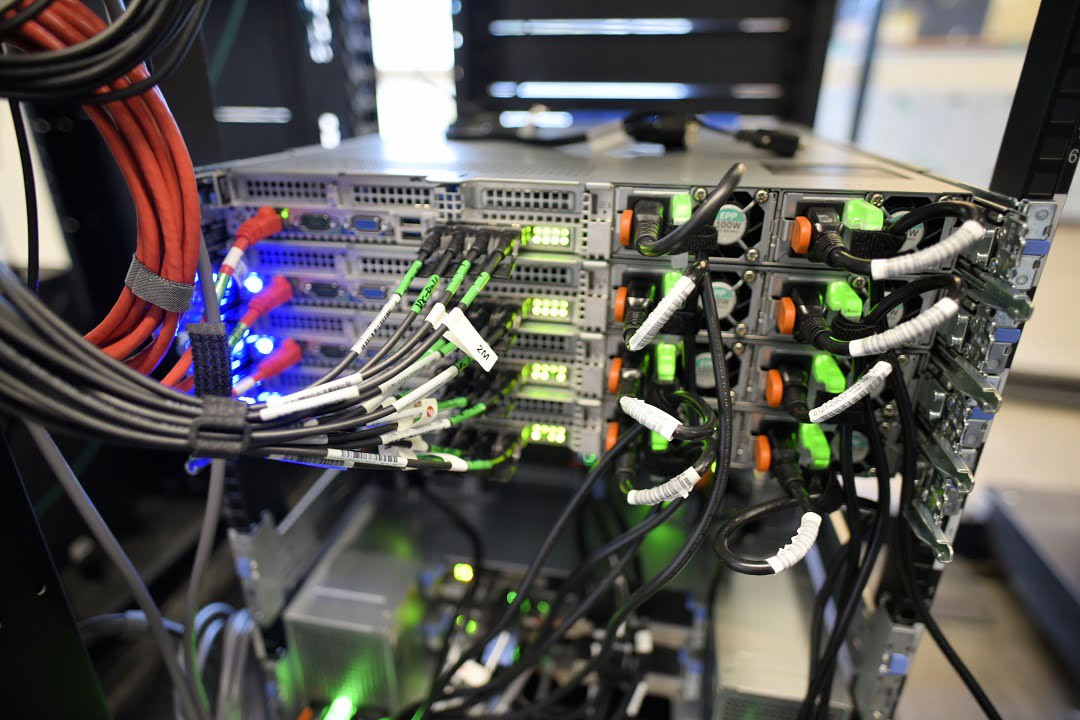
The defining feature of the Gallagher application is that it resides on a virtual server on a physical server inside the school’s network room. Door controllers are brought onto the network remotely and then aggregated into this virtual server, which is fully redundant and supported by a 15-hour UPS. Just to put this into perspective, when I ask where the Gallagher server is, Pfitzner waves in the direction of a server rack.
“It’s not a separate physical server,” he explains. “A lot of major corporates like a virtual server because it doesn’t introduce another brand of hardware into their network. Using a virtual server meshes with existing maintenance regimes and it’s easier to implement. The physical parts of the security solution are the Bosch servers, which are there. Over here we have the core switches – the fibre goes from these to the risers and then out to edge switches on each level, with our field devices linked to those edge switches.”
According to Pfitzner, there were some small issues in the field.
“We had some challenges relating to installing system components and having later additions getting in the way – things like exit signs which required we move cameras. But for the most part the system came together without too many problems.”

You’d expect a system like this to require hands-on management but while the facilities manager at the site has management and control of the access and CCTV solutions, the system requires very little day to day support and that’s the way it was intended to be.
“Both access control and CCTV systems are quite hands-off – for instance, the Gallagher Command Centre solution has a suite of standard reports that can be generated automatically, and alarm events go to SA Police Security Services,”
Pfitzner explains. “The system monitors itself and is very stable. The only thing required is managing cardholders and keeping an eye out for low battery alarms on the Salto door locks. This requires a simple battery change the school service team can easily handle, though there is a remote battery pack that allows the door to be opened if configured notifications are missed and the battery goes flat.”
Pfitzner says the integration also gave space for some creativity, including the ability to display duress alarms as part of the occupant warning system via LCD. In this case, the team integrated the security system with an MP3 player connected to the fire panel through the EWIS, so warning tones are sent around the building at the same time messages are displayed on an LCD screen. The idea is that in the future this functionality will be automated and controlled by staff using mobile devices.
Plans for the Future
Could Adelaide Botanic High School a template for schools of the future? The potential is there, according to Dunleavy.
“In the sense of safe zones, yes, but in terms of replacing standard school buildings with vertical schools, probably not so much,” he says. “Certainly, some of the scoping and projects going on now are based on the functionalities we developed here. Not every school is the same, but we can replicate safe zones and introduce economical, flexible expansion with more wireless doors while experiencing no loss of management capability.”
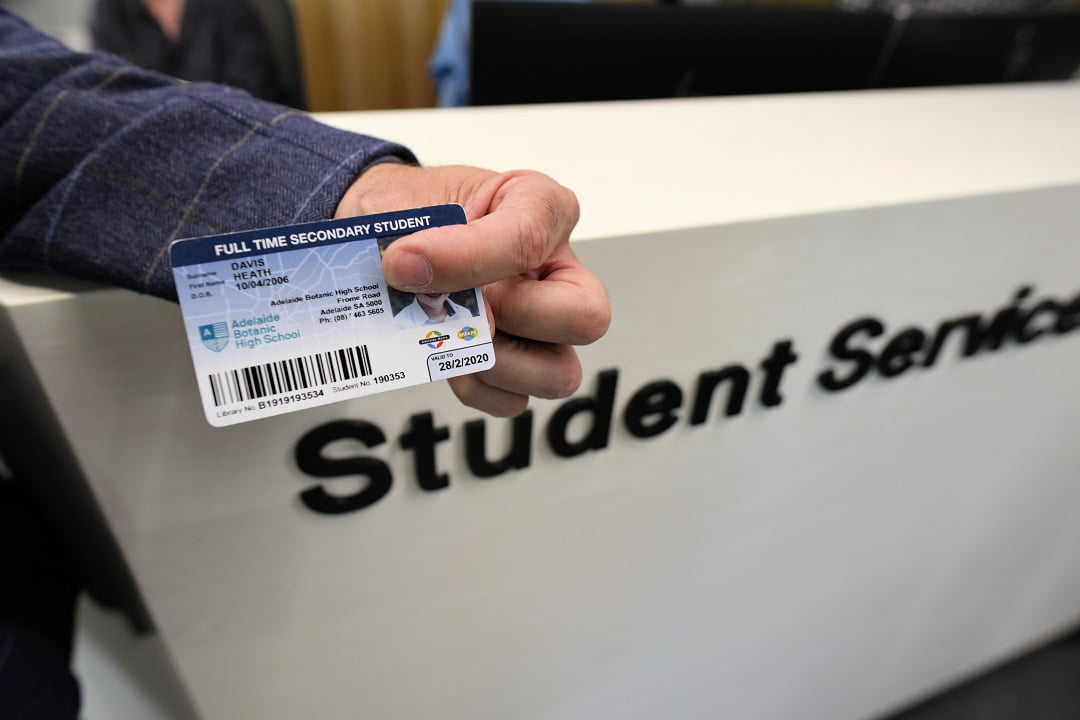
According to Dunleavy, one of the most important aspects of the integration at Adelaide Botanic High School is the IP.
“What we have here is uniformity of setup for things like doors and access rights that can be replicated as multiple instances on a virtual server – that’s the idea in the future,” he explains. “Gallagher has worked with us to create a naming convention – a technical standard document – that any channel partner can apply to any site.
“This is important, as we will have 3 enormous new schools operational by 2022 and these may be on the same virtual security system – we want to own the infrastructure and own the setup. Facilities-wise any provider might win a contract but with IT, Gallagher and Access Datacom’s involvement we can make sure we have an organisation-wide standard, so it’s not just about this building.”
How involved was the IT department in this integration?
“IT was a partner at the end, and they are front and centre in developing a solution for the future, handling things like network restrictions, the difference between the corporate network and the school network, how we access the network, etc,” Dunleavy says. “We also want to be able to centrally manage multiple sites in the future and IT will be heavily involved there, too.”
Conclusion
According to Harris, Adelaide Botanic High School is a lighthouse project for the South Australia’s Department for Education.
“They wanted a solution that gave them every functionality and I believe they have got that – it’s been a unique project – having every student on campus walking around with a defence level DESFire credential, having a virtual enterprise environment with the capacity to expand in the future, having the ability to undertake lockdowns from the field – all these are tremendously powerful functionalities,” he says.
At the end of our walk-through we take a trip to the top of the building. From here the rear of the school can be seen in context, an island in a grass sea, the tree shore stretching away into the parkland behind it. Not for the first time, I can’t help feeling this site has simultaneously given an opportunity and demanded SA Education Department’s security team discover exactly what the latest technologies are capable of.
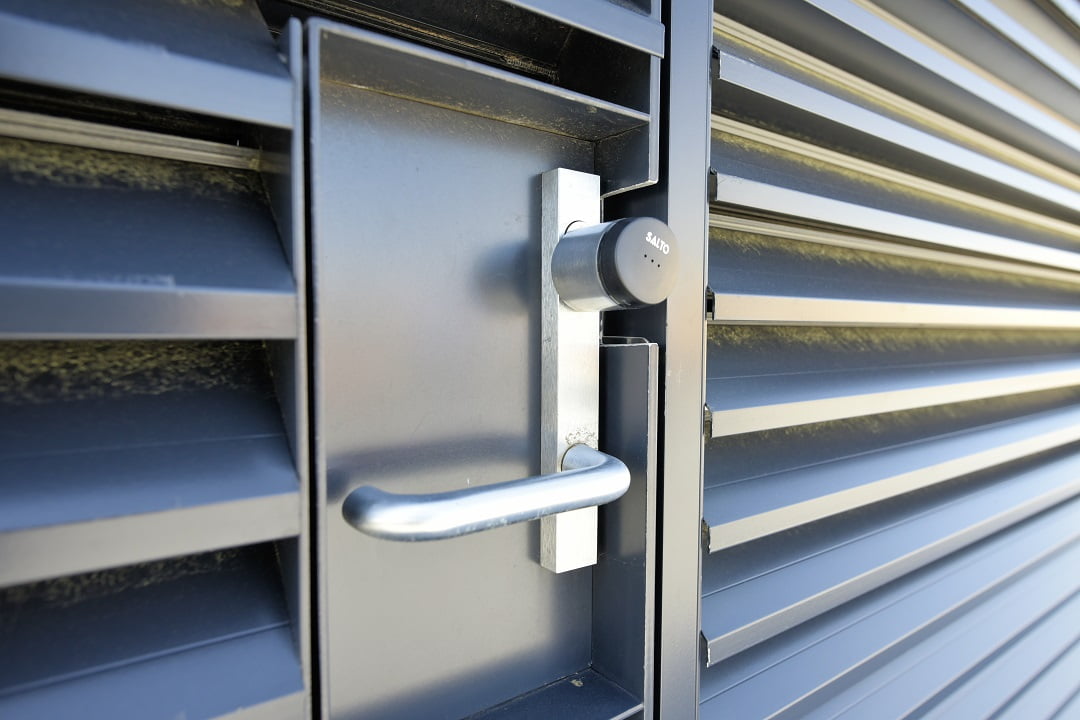
It must have been pleasing to have brought these ideas to fruition, I suggest. This is not the sort of school security solution you typically see.
“Yes, it’s been extraordinary to get everything that you wanted delivered but for a few minor exceptions – the system has been delivered as requested,” agrees Dunleavy. “It’s been an extraordinary opportunity to build a school that architecturally, operationally and from a security perspective, is utterly unlike anything else.
“Important, too, the response from staff has been completely positive. We don’t get complaints about lost keys, not being able to access an area – the school team needed to learn how to manage the system and we needed staff – and students – to understand that this school was not like any other.”



